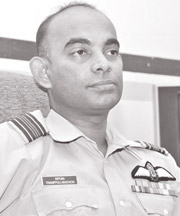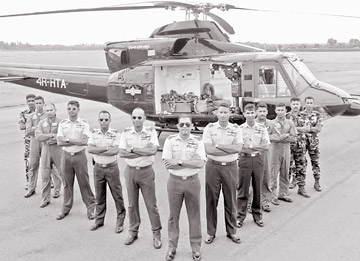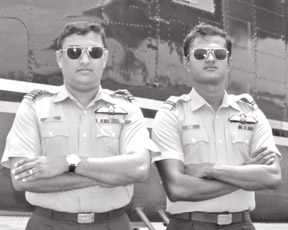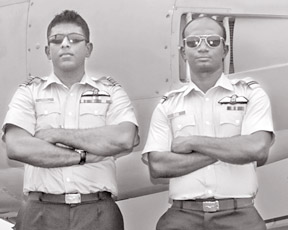SLAF's daring missions to save lives
By Dhaneshi Yatawara
The wind blew at 30 knots and there was no decrease. The clouds and
the rain made it impossible to see anything beyond 1,000 metres. The
weather was becoming turbulent, creating an adverse situation. This was
how the sky was like when the Sri Lanka Air Force Bell412’s and Y12’s
took off to search and rescue the missing and stranded fishermen who
have gone to the sea in the wee hours of June 8. It was a fateful day
for Sri Lankans and specially for the fishing community living along the
coastal line where more than 50 fishermen perished.
 |
 |
Squadron
Leader Nipuna
Thanippuli Arachchi |
Wing Commander
Channa Dissanayake |
Information was flowing in from many people and relevant officials on
spotting possible survivors in the sea and in these conditions the best
search option lay with the Sri Lanka Air Force (SLAF) ready to face any
challenge. Sri Lanka Air Force received instructions to conduct search
and rescue missions in the surprisingly adverse weather.
Thus, with very short notice and with 10 - 15 minutes preparation
time the SLAF Squadrons No. 4 and No. 8 prepared for the search and
rescues.
The first airborne were the Y12’s of the No 8 squadron with Squadron
Leader Daminda Rambukwella as the Captain pilot with the co pilot flying
Officer Dilshan Kithsiri. “We were instructed to do the search
operations initially so that the helicopter squadron can directly reach
the locations,” said Squadron Leader Rambukwella.
“It was a very adverse weather condition with strong winds. The cloud
base was 500 feet. So we had to fly very low,” Sq. Ldr. Rambukwella
said.
Then the Y12 received instructions to proceed towards Beruwala.
Reaching Beruwala the two pilots spotted one survivor about five
kilometres North of the Beruwala light house. We were communicating with
the bell412 helicopter throughout and we sent this message to them,” he
said. The Y12 continued their search operations more in Beruwala and
spotted three more survivors, this time more into the deep sea – about
25 – 30 kilometres from the light house.
 |
|
The Bell 412 team |
Though we informed the Bell 412 the weather at that moment became so
adverse we had to look for an alternative to rescue these people, said
Rambukwella. Fortunately they spotted a trawler located very close and
the Y12 pilots managed to communicate with them in getting the boat to
rescue the survivors.
“But the winds and the sea was so rough the boat could not see the
victims. So the helicopter guided the trawler to the survivors and the
trawler managed to rescue the three people,” said Rambukwella.
For Wing Commander Channa Dissanayake the Commanding Officer of the
Squadron No.4 – the Bell helicopter fleet - it was a good day of
judgement of how their versatility and flexibility – testing how fast
they could switch roles from VIP transportation to rescue missions in a
deadly storm. Ironically for the No.4 squadron it was exactly after one
week from celebrating the 48 years of the fleet.
“This emergency call was after a long time. In all other occasions we
had sufficient time to prepare ourselves for that mission. But in this
case with the sudden changes in the weather pattern time was a limited
crucial factor,” said Wing Commander Channa Dissanayake starting to
explain the true stories of real life heroism.
Worst case scenario
“In that weather as long as the helicopter is head on with the gusty
wind, the situation is under control. Yet when the wind hits from the
side creating what we call a cross wind situation, the problems start
becoming worse making the helicopter go out of control. Facing that
cross wind coming at 30 knots the helicopter tends to turn and totally
go out of control,” Wing Comm. Dissanayake explained.
One of the Gunners, Flight Sergeant Gomes explained a deadly
situation their rescuer faced during the mission. Gomes spotted a the
victim and informed the pilot that he was positioned at 3 O’ clock. His
fellow Airman Chaminda got down with the rope.
“The sea was very rough. I could see from the helicopter how Chaminda
was struggling to avoid being washed away by heavy waves,” Gomes said.
 |
 |
The Beech King
Air (B-200T Beechcraft)
surveillance aircraft with pilots |
The Beech King Air (B-200T
Beechcraft)
surveillance aircraft with pilots |
The struggle between the rescuer and the victim was intense. The
waves were pushing Chaminda 20 -25 metres away from the victim.
Finally he managed to rope the survivor and by then Chaminda was also
in a crucial situation. Yet the rescuer’s job was not done. Hanging on
to the rope many metres away from the helicopter and soaked in cold
salty water after an intense struggle with the rough sea, the airman had
to keep the survivor safely until they reached the landing point.
In those minutes the life of the survivor depended on the skill of
this airman. After rescuing the person from Beruwala sea the Bell crew
landed Chaminda and the survivor at the Beruwala fishing harbour and set
off to save another three survivors on the information they received
from the Y12 aircraft that was on search operation in the same area.
Another Bell 412 Helicopter with Captain pilot Squadron Leader Nipuna
Thanippuli Arachchi and Co-Pilot Squadron Leader Indika Wijethilake
along with their crew with Corporal Nanayakkara, Corporal Sampath,
Corporal Nawaratne and Leading Aircraftman Kumara were hovering and
flying over seas off Dehiwala for more than two hours rescuing
fishermen.
“Normally a rescuer would start roping down at 100 – 80 feet height.
The airman going down for rescue communicate with us using hand signals
and it is us who have to communicate what our man down says to our
pilots. During trainings we spend just five minutes to rescue a person
but with this weather it took us nearly twenty minutes,” said the
gunners.
The rescuers have to manage the panicking survivor who could do
anything in his unconscious mind. It is the rescuer airman who should be
strong enough to hold the victim tight and soft enough to calm his mind.
From Dehiwala the crew had to take the survivor to the Galle Face
green as it is there the medical teams waited to receive them. After
leaving the survivor in the hands of the medical team, the Bell412
returns to the same location to rescue the other person.
“The final call came to me from my Director Operations around 6.15 p
m. Darkness was setting in and flying in the dark specially in such an
adverse weather is something that we do not normally do. Yet if we tried
we could save another life. Therefore, we took the risk,” said Wing
Comm. Dissanayake.
The No.4 squadron is with 13 pilots along with 235 technical staff.
At an instance there will be 65 on duty. We have a separate duty crew
called ASR – Air Sea Rescue.
That crew about 23 is responsible for day to day servicing and
preparations of the helicopters.
“Bell 412 is a multi role aircraft. This is meant for rescue
missions. This can be fitted with all the rescue equipment as well. This
is not only for carrying VIP. This is for search and rescue missions,
casualty evacuation and for carrying troops. |


